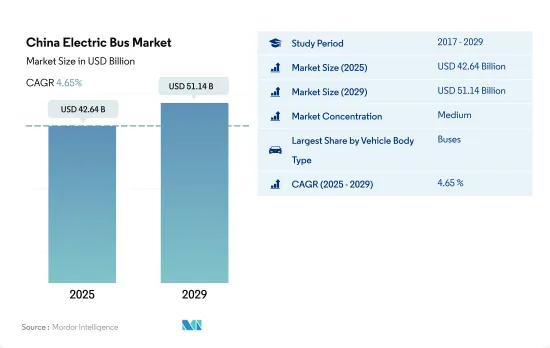 |
市場調查報告書
商品編碼
1693625
中國電動公車市場:市場佔有率分析、產業趨勢與統計、成長預測(2025-2030)China Electric Bus - Market Share Analysis, Industry Trends & Statistics, Growth Forecasts (2025 - 2030) |
||||||
※ 本網頁內容可能與最新版本有所差異。詳細情況請與我們聯繫。
預計2025年中國電動公車市場規模將達到426.4億美元,到2029年預計將達到511.4億美元,預測期間(2025-2029年)的複合年成長率為4.65%。

中國電動公車市場趨勢
政府措施和強勁的OEM投資推動中國電動車銷售快速成長
- 政府減少汽車燃料排放的計畫正在鼓勵消費者轉向更環保的汽車。 2020年11月,中國政府宣布將在2035年前禁止石化燃料汽車,並承諾在新能源計畫下銷售100%新能源汽車。這導致對電動車的需求增加。透過採取此類法規,中國近年來加強了電動車及其所用各種電池組的銷售。
- 政府為消費者和製造商推出了各種計劃和獎勵,以促進和加強該國對電動車的需求。 2022年5月,政府宣布重新引入補貼計劃,以增加電動車的銷售量。此外,政府還將為購買電動車的客戶提供1,500美元的補貼。這些因素正在鼓勵消費者投資電動車,2022 年電動車銷量將比 2021 年成長 2.90%。
- 電動車需求的不斷成長迫使OEM計劃擴大電動車類別的開發和生產。 2021年,通用汽車宣布計劃在2025年將電動和自動駕駛汽車方面的支出增加到200億美元。該公司計劃在2023年推出20款新型電動車,並計劃在中國每年銷售超過100萬輛電動車。因此,預計這些因素將在 2024 年至 2030 年期間推動中國電動車市場的發展。
中國電動公車產業概況
中國電動客車市場格局適度整合,前五大企業市佔率合計為59.80%。市場的主要企業有:奇瑞汽車、重慶長安汽車股份有限公司、金龍聯合汽車工業、浙江吉利控股集團和鄭州宇通客車(按字母順序排列)
其他福利
- Excel 格式的市場預測 (ME) 表
- 3個月的分析師支持
目錄
第1章執行摘要和主要發現
第2章 報告要約
第3章 引言
- 研究假設和市場定義
- 研究範圍
- 調查方法
第4章 產業主要趨勢
- 人口
- 人均GDP
- 消費者汽車支出(cvp)
- 通貨膨脹率
- 汽車貸款利率
- 共乘
- 電氣化的影響
- 電動車充電站
- 電池組價格
- 新款 Xev 車型發布
- 燃油價格
- OEM生產統計
- 法律規範
- 價值鍊和通路分析
第5章市場區隔
- 燃料類別
- BEV
- FCEV
- HEV
- PHEV
第6章 競爭格局
- 重大策略舉措
- 市場佔有率分析
- 商業狀況
- 公司簡介
- Anhui Ankai Automobile Co. Ltd.
- BYD Auto Co. Ltd.
- Chery Automobile Co. Ltd.
- Chongqing Changan Automobile Company Limited
- CRRC Electric Vehicle Co. Ltd.
- FAW Toyota Motor Co. Ltd.
- Higer Bus Company Ltd.
- King Long United Automotive Industry Co. Ltd.
- Nanjing Golden Dragon Bus Co. Ltd.
- Shanghai Sunwin Bus Corporation.Ltd.
- Zhejiang Geely Holding Group Co. Ltd
- Zhengzhou Yutong Bus Co. Ltd.
- Zhongtong Bus Holding Co. Ltd.
第7章:CEO面臨的關鍵策略問題
第 8 章 附錄
- 世界概況
- 概述
- 五力分析框架
- 全球價值鏈分析
- 市場動態(DRO)
- 資訊來源及延伸閱讀
- 圖片列表
- 關鍵見解
- 數據包
- 詞彙表
The China Electric Bus Market size is estimated at 42.64 billion USD in 2025, and is expected to reach 51.14 billion USD by 2029, growing at a CAGR of 4.65% during the forecast period (2025-2029).

China Electric Bus Market Trends
Government initiatives and strong OEM investments drive rapid drowth in electric vehicle sales in China
- The programs launched by the government to reduce gas emissions caused by vehicle fuels are encouraging consumers to shift to green vehicles. In November 2020, the government of China announced a ban on fossil fuel vehicles by 2035, clearly stating the selling of 100% new energy vehicles under the new energy program. As a result, the demand for electric cars increased. Adopting such regulations enhanced the sales of electric cars and various types of battery packs used in them in China in recent years.
- The government is introducing various schemes and incentives for customers and manufacturers to promote and enhance the demand for electric vehicles in the country. In May 2022, the government announced the reintroduction of the subsidy program to increase the sales of electric vehicles. Moreover, the government will allocate a subsidy of USD 1500 to customers opting for an electric car. Such factors have encouraged customers to invest in electric mobility, which further has increased the sales of electric cars by 2.90% in 2022 over 2021 in China.
- The growing demand for electric vehicles has forced OEMs to plan to increase development and production in the electric vehicle category. In 2021, General Motors announced its plans to raise its spending on electric and autonomous vehicles to USD 20 billion by 2025. The company is expected to launch 20 new electric models by 2023 and aims to sell more than 1 million electric cars a year in China. As a result, these factors are expected to drive the electric vehicle market in China during the 2024-2030 period.
China Electric Bus Industry Overview
The China Electric Bus Market is moderately consolidated, with the top five companies occupying 59.80%. The major players in this market are Chery Automobile Co. Ltd., Chongqing Changan Automobile Company Limited, King Long United Automotive Industry Co. Ltd., Zhejiang Geely Holding Group Co. Ltd and Zhengzhou Yutong Bus Co. Ltd. (sorted alphabetically).
Additional Benefits:
- The market estimate (ME) sheet in Excel format
- 3 months of analyst support
TABLE OF CONTENTS
1 EXECUTIVE SUMMARY & KEY FINDINGS
2 REPORT OFFERS
3 INTRODUCTION
- 3.1 Study Assumptions & Market Definition
- 3.2 Scope of the Study
- 3.3 Research Methodology
4 KEY INDUSTRY TRENDS
- 4.1 Population
- 4.2 GDP Per Capita
- 4.3 Consumer Spending For Vehicle Purchase (cvp)
- 4.4 Inflation
- 4.5 Interest Rate For Auto Loans
- 4.6 Shared Rides
- 4.7 Impact Of Electrification
- 4.8 EV Charging Station
- 4.9 Battery Pack Price
- 4.10 New Xev Models Announced
- 4.11 Fuel Price
- 4.12 Oem-wise Production Statistics
- 4.13 Regulatory Framework
- 4.14 Value Chain & Distribution Channel Analysis
5 MARKET SEGMENTATION (includes market size in Value in USD and Volume, Forecasts up to 2029 and analysis of growth prospects)
- 5.1 Fuel Category
- 5.1.1 BEV
- 5.1.2 FCEV
- 5.1.3 HEV
- 5.1.4 PHEV
6 COMPETITIVE LANDSCAPE
- 6.1 Key Strategic Moves
- 6.2 Market Share Analysis
- 6.3 Company Landscape
- 6.4 Company Profiles
- 6.4.1 Anhui Ankai Automobile Co. Ltd.
- 6.4.2 BYD Auto Co. Ltd.
- 6.4.3 Chery Automobile Co. Ltd.
- 6.4.4 Chongqing Changan Automobile Company Limited
- 6.4.5 CRRC Electric Vehicle Co. Ltd.
- 6.4.6 FAW Toyota Motor Co. Ltd.
- 6.4.7 Higer Bus Company Ltd.
- 6.4.8 King Long United Automotive Industry Co. Ltd.
- 6.4.9 Nanjing Golden Dragon Bus Co. Ltd.
- 6.4.10 Shanghai Sunwin Bus Corporation.Ltd.
- 6.4.11 Zhejiang Geely Holding Group Co. Ltd
- 6.4.12 Zhengzhou Yutong Bus Co. Ltd.
- 6.4.13 Zhongtong Bus Holding Co. Ltd.
7 KEY STRATEGIC QUESTIONS FOR VEHICLES CEOS
8 APPENDIX
- 8.1 Global Overview
- 8.1.1 Overview
- 8.1.2 Porter's Five Forces Framework
- 8.1.3 Global Value Chain Analysis
- 8.1.4 Market Dynamics (DROs)
- 8.2 Sources & References
- 8.3 List of Tables & Figures
- 8.4 Primary Insights
- 8.5 Data Pack
- 8.6 Glossary of Terms










